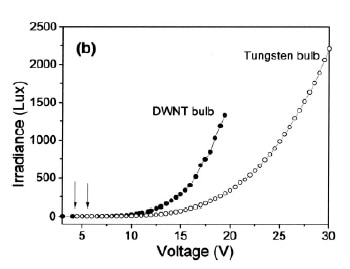Light bulbs have not changed much since they were invented by Thomas Edison 125 years ago. However, physicists in China have now made a light bulb in which the conventional tungsten filament is replaced by carbon nanotubes. The new design has several advantages over traditional light bulbs and could be available in less than five years (J Wei et al. 2004 Appl. Phys. Lett. 84 4869).

Jinquan Wei and colleagues from Tsinghua University and Bingqing Wei at Louisiana State University started by using chemical vapour deposition to make highly pure nanotubes. Next they soaked the resulting bundles of nanotubes in alcohol and assembled the structures into long filaments as the alcohol evaporated. Finally they replaced the tungsten filament in an ordinary 40-watt light bulb with the nanotube filaments and sealed the bulb under vacuum (figure 1).
The team found that the nanotube filaments emit light across their length and that they have a lower threshold voltage for light emission than tungsten filaments — 3 to 5 volts compared with 6 volts. More importantly, the nanotube filaments emit more light than tungsten filaments at the same applied voltage (figure 2). The light is a combination of black body radiation and electroluminescence.
Wei and colleagues were surprised to find that, unlike tungsten filaments, the resistance of the nanotube filaments did not change with temperature up to about 1750 Kelvin. This means that the nanotube filaments could be used to make precision resistors that work at high temperatures. Moreover, they found that the bulbs could operate continuously at 25 volts for more than 360 hours, and that they continued working after being turned on and off more than 5000 times.
“More work needs to be done but I would say the bulbs could be available within three to five years,” Bingqing Wei told PhysicsWeb.




